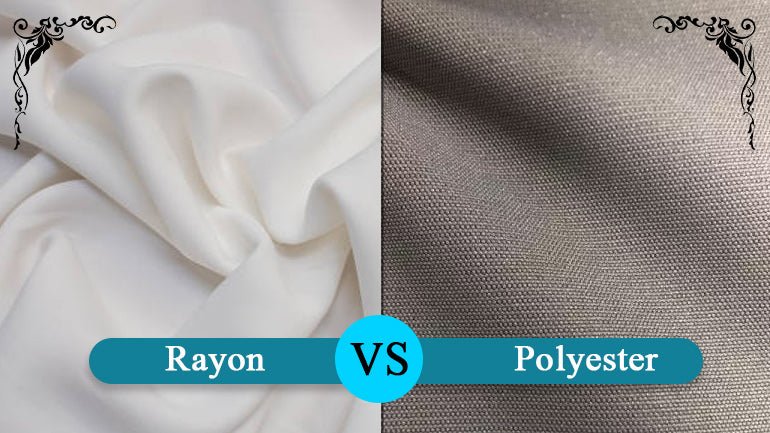Both rayon and polyester can be used depending on the purpose of your project. Although rayon and polyester can be used in many similar techniques, their origins are very different. One of the most significant differences between rayon and polyester is that rayon is made with natural fibers and some chemicals, while polyester is made with petroleum products and a lot of added chemicals.
Rayon, which is a semi-synthetic fiber, and Polyester (a synthetic fiber) are both very popular in apparel and furnishings. They have similar heat retention, moisture wicking, breathability, and heat retention. Rayon fabric is more flexible than polyester fabric and has a better drape. However, polyester fabric is much stronger. Both rayon fabric and polyester fabric are very affordable to make in large quantities and are therefore considered unsustainable.
You can read this article to find out the difference between rayon and polyester. It contains all you need to know in order to make the best choice for your next sewing project. This will only take a few moments of your time.
What is Polyester?
Polyester refers to a combination of two words -polymer and ester. Polymer refers to a chemical compound made up of many smaller molecules. Ester refers to a natural or organic compound formed through the reaction of acid and alcohol.
Polyester is a synthetic fiber. They are made from petroleum. To make polyester, a scientific process called Polymerization takes place. It's also known as Polyethylene Terephthalate (or PET).
Polyester is a popular textile material. Many fashion designers use them. They can be used to make clothes, furniture, curtains, and stationery. They are strong and can be stretched to a great extent. They don't require special care like silk fabric and cotton fabric. They are stronger than cotton and can withstand water.
What is Rayon?
Rayon comes from the French word "Bayonne," which is French for shine or glimmer. Semisynthetic fiber is made from regenerated cellulose. It is made of wood pulp. Rayon, also known as artificial silk, is characterized by the same characteristics as silk, including softness and shininess. The chemical properties of absorbent-rayon fibers are similar to those of cotton.
Types of Rayon
- Regular rayon
- Cuprammonium rayon
- High wet modulus rayon
- High tenacity modulus rayon
Difference between Rayon and Polyester
|
Number |
Rayon |
Polyester |
|
1. |
Semi-synthetic fiber |
Synthetic fiber |
|
2. |
Best for Warmer climates and environments |
Best for cold climates and environments |
|
3. |
Special care is required for this delicate fabric |
Durable material |
|
5. |
Can easily wrinkle |
Wrinkle resistance |
|
6. |
It can tear easily, just like cotton. |
Its tear resistance and can be used for rough or difficult situations |
|
7. |
It has a great drape. |
It doesn't drape so well |
|
8. |
Washing can cause shrinking and stretching |
it will never shrinkage and stretched after wash |
|
9. |
It can be very smooth to the touch |
It is not as smooth as it appears when you touch it |
|
10. |
It is designed to look like silk |
Built to last a lifetime |
|
11. |
It can be dyed very easily |
It takes a lot of effort to change the color |
|
13. |
Breathable |
Not breathable |
|
14. |
Absorbs moisture |
It resists moisture and doesn’t absorb it as well |
|
15. |
Expensive |
Cheaper than rayon |
Rayon vs Polyester
It is not difficult to see that rayon and polyester have different characteristics. They are both fabrics, but they have many differences, from the type of fabric to their characteristics, forms, and uses. It's all about being fabric-savvy when it comes to choosing between them. If you see the fabric that is used in high temperatures, it must be rayon. If you see someone wearing a cloth that is water-resistant, it is most likely made of polyester.
Also read for Satin vs Silk.
Is Rayon Good for Summer or Winter?
Rayon a lightweight fabric and drapes well. Rayon is breathable and allows heat to escape, so it does not sweat excessively. Rayon is made from very thin fibers, which allow it to breathe better than other fabrics. It also has a lightness that keeps it from sticking to the skin in hot conditions. Rayon is a great fabric for summer dresses and sportswear because it is both comfortable and cool to wear. So rayon is not recommended to wear in winter.
Is Rayon Warmer than Polyester?
Is Rayon Warmer Than Polyester? Again, the answer will be No. Polyester can be and is made for cooler temperatures, but when we talk about the Rayon fabric, that allows heat to escape from your body which helps you cool down.
Is Rayon or Polyester more Stretchy?
One-hundred-percent rayon does not stretch. Rayon is made from wood pulp. It does not have the natural ability to stretch like spandex. Rayon even has less stretch than polyester and other synthetic materials.
Polyester vs Rayon For Clothing
Every fabric has a different fabric that can be used for different purposes. Polyester is a great fabric for when you get messy and dirty because it resists shrinking, wrinkles and tears. Rayon is more appealing than polyester. However, rayon can withstand harsh and difficult activities that rayon cannot handle.
Rayon drapes well and looks good; that makes it so special. This fabric is much more versatile than polyester. You can move, sit and stand far better than with polyester.
Both fabrics have different properties, so you can use them according to your needs and requirements.
Is Polyester Breathable?
Polyester is not breathable. Polyester is water-resistant. This means that you will be walking around with a lot of moisture and a wet patch between your shirt and you all day.
What Material is Rayon Similar to?
Rayon is similar to silk fabric and has a smooth texture like silk. It is also can be easier to maintain. Rayon has been used in lingerie, blouses, and other items.
Is Polyester Softer than Cotton?
Polyester is a more dense and heavier fabric that does not feel soft like cotton. Polyester fabric is popular because it has quick-drying and moisture-wicking qualities.
Is Polyester Cheaper than Cotton?
Although polyester tends to be less expensive than cotton, its actual cost is determined by how popular the fabric is.



